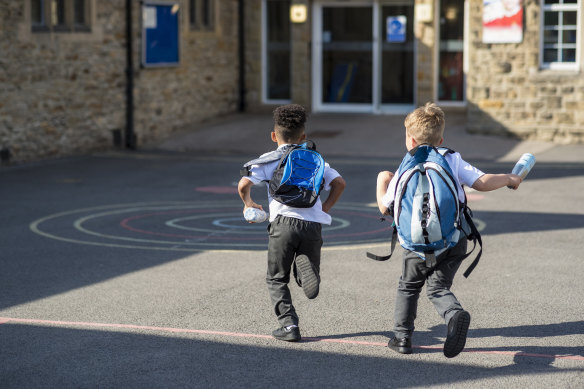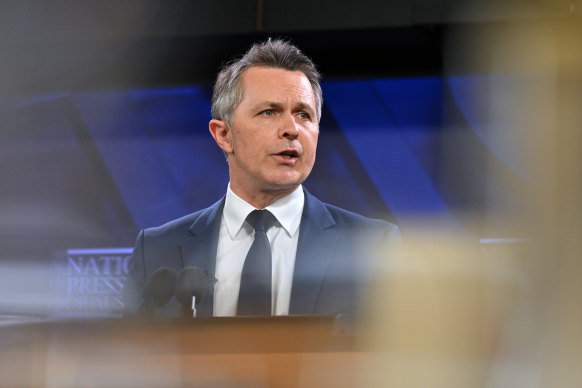By Sherryn Groch and Robyn Grace
Five states have banded together to demand the federal government double how much extra cash it will pump into public schools, as they hit out at a new deal for West Australian state schools that delivered a smaller increase.
WA’s public schools will get an additional $777 million in Commonwealth funding over the next five years in a deal announced Wednesday, raising the long-standing federal share of money from 20 per cent to 22.5 per cent by 2026.

A federal government deal to boost the level of Commonwealth funding to Western Australian state schools has kicked off a nationwide funding brawl.Credit: iStock
But Queensland, NSW and Victoria are among states doubling down on calls for the Commonwealth to lift its share even higher to 25 per cent.
This masthead can reveal that education ministers from Victoria, NSW, South Australia, Queensland, Tasmania and the ACT have written to federal Education Minister Jason Clare rejecting a proposed 2.5-percentage point increase.
The states provide the lion’s share of public school funding in Australia – 80 per cent to the Commonwealth’s 20 per cent, under current agreements.
But all jurisdictions, except the ACT, are still falling billions of dollars short every year of minimum resourcing standards, known as the Schooling Resource Standard, that were agreed under the Gonski reforms a decade ago to fund schools according to need.
The letter from education ministers, seen by this masthead, called for a greater spend by the Commonwealth, which has more revenue-raising power than the states. But it also asked the Albanese government to use its “levers” to help fix the national teacher shortage crisis, and to consider a long-term school infrastructure fund outside the Schooling Resource Standard, as is available for private schools.
“Our respective jurisdictions are experiencing unprecedented pressures from ongoing population growth, resulting in the need to build new schools, support additional infrastructure and upgrade existing facilities,” the joint letter read.
Clare has vowed to fix the funding gap that has left almost all Australia’s public schools underfunded and most of its private schools overfunded, but says states must stump up more cash, too.
An analysis by this masthead found loopholes and the watering-down of the Gonski agreements meant the “missing 5 per cent” in public school funding is closer to a shortfall of about 15 per cent in jurisdictions such as Victoria, Queensland and the Northern Territory.

Education Minister Jason Clare.Credit: AAP
WA will have to kick in the same amount as the Commonwealth under its deal, taking the total extra funding for schools in WA to $1.6 billion. Yet, a Coalition-era loophole that allows states to write off 4 per cent of their funding for public schools on other non-school spending – such as capital depreciation and even private school buses – will remain open for WA.
Governments in Victoria, NSW, SA, and Queensland did not say if they would match any extra federal spend dollar-for-dollar.
Clare’s office confirmed that the 2.5-percentage point Commonwealth increase so far applied only to WA, as negotiations with other jurisdictions continued. The federal offer may yet go up for some, particularly the NT where it already spends more as the territory struggles to fully fund schooling.
Clare told this masthead he had spoken to other state education ministers overnight but did not answer questions on negotiations and potential offers put forward.
“No public school is on track to reach 100 per cent [of the resourcing standard],” he conceded, except in the ACT, which already fully funded public schools.
“WA’s been quick off the blocks to do a deal here,” he said. “I want to work with every state and territory and make sure that we can do the same.”
In Victoria, where a particularly tight state budget looms this year, Premier Jacinta Allan said she expected an extra 5 percentage points from the Commonwealth as part of negotiations. “We expect our fair share,” she said.
NSW Education Minister Prue Car said state governments were facing unprecedented pressure to continue to provide “world-class services to a growing population” and “public schools have not been funded to the levels agreed” under Gonski. NSW last year vowed to accelerate its funding for public schools to reach the Schooling Resource Standard by 2025.
Parliamentary costings suggest a boost in Commonwealth funding of 5 percentage points for all jurisdictions would cost about $4.7 billion over four years.
WA Education Minister Tony Buti said a “no disadvantage clause” in its new federal agreement, which was yet to be formally signed, meant that “if any negotiations with other states results in further improvement, we will receive them”.
Under the deal, disadvantaged schools will get the money first in 2025, and strings will apply to how the Commonwealth money is spent to better target resources to help student and staff wellbeing and those falling behind their peers.
Those conditions are based on recommendations from an expert-led review that last month called for public schools to be fully funded urgently, as the achievement gap between the richest and poorest students grows.
While the detail is still being worked through, Clare said the conditions were not intended to create more red tape for public school principals already struggling to manage tight budgets.
Clare pointed to one proposal in that report he was now considering: paying experienced teachers more to work in the most disadvantaged schools.
“That report also talks about transparency and accountability,” he said. “Making sure that we can track the money [so] it’s invested in the ways that are going to help our kids to succeed.”
Clare said the WA funding was “new money” not offset by changes to non-government schools, which are still overfunded by hundreds of millions of dollars a year but now “tracking down” to be at the Schooling Resource Standard by 2029.
The Australian Education Union, which backs a 5 percentage point boost in Commonwealth funding for public schools, said the WA deal should be seen as a first step rather than a final agreement because WA’s funding share was still artificially inflated by about $230 million through the 4 per cent loophole.
“Short-changing our schools is short-changing our students at a time when we can least afford it,” said AEU federal president Correna Haythorpe.
“We have a teacher shortage crisis caused by crippling workloads, unacceptable achievement gaps between children from different backgrounds and locations and a worrying decline in student mental health and wellbeing.”
Clare did not say whether he would scrap the 4 per cent loophole allowance for states or introduce tougher accountability on their funding pledges, as Labor previously committed to do while in opposition.
SA Education Minister Blair Boyer said he had written to Clare “seeking the Commonwealth increase its funding share” by 5 percentage points and “raised the importance of school infrastructure funding in the next agreement.”
The Queensland government agreed a 5 percentage point increase was needed, telling this masthead that “Queensland schools and teachers provide some of the most geographically dispersed and remote learning anywhere in Australia”.
With Lucy Carroll and Angus Thompson
Start the day with a summary of the day’s most important and interesting stories, analysis and insights. Sign up for our Morning Edition newsletter.